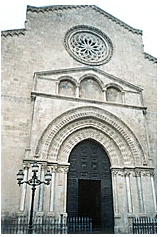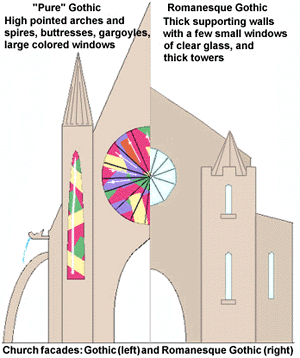...Best of Sicily presents... Best of Sicily Magazine. ... Dedicated to Sicilian art, culture, history, people, places and all things Sicilian. |
by Carlo Trabia | |||
Magazine Index Best of Sicily Arts & Culture Fashion Food & Wine History & Society About Us Travel Faqs Contact Map of Sicily
|
The earliest Norman churches in England were Romanesque, as were those those in Sicily. The difference is that before the Normans' arrival Sicily had a long tradition of mosques and Byzantine (Orthodox) churches built in the Romanesque style, while most of England's Saxon stone churches were rather more simple in design. Most cloisters are essentially Romanesque. In England and France a number of Romanesque churches were converted to Gothic plans during the twelfth and thirteenth centuries. In Italy the true Gothic never made substantial inroads, though prominent exceptions like Milan's cathedral stand out. Instead, a kind of mised style evolved. This so-called "Italian Gothic" or "Romanesque Gothic" was essentially an updated interpretation of the Romanesque favored by diocesan sees as well as the religious orders such as the Franciscans. Despite the addition of a few Gothic details, there wasn't much "Gothic" to it. No external buttresses, narrow naves, high towers, large windows or gargoyles. The Gothic is often considered an evolution in architecture. Structurally,
it did represent new principles, but it did not supplant the Romanesque
entirely or immediately. Late in the There is no simple explanation for the lack of a pure Gothic movement in Sicily. In later periods (particularly the fifteenth century) Sicilian architects were late to embrace the certain new styles, such as the Renaissance movements, of other regions. Nor did the Neo-Gothic ever gain a solid foothold in southern Italy. The Catalonian Gothic, however, was introduced in the fifteenth century. One of the rare examples of high medieval Gothic architecture in Sicily is the largely-destroyed church of Saint Mary of the Germans in Messina, constructed on orders of Henry VI (father of Frederick II) for the Teutonic Order in the 1190s. Some external walls have been reconstructed but, sadly, little remains of the original structure except for a few arches. The epitome of the Italian Romanesque Gothic in Sicily is the Church of Saint Francis of Assisi (shown here) in Palermo, but it is not unique. Most of the Sicilian churches constructed between 1250 and 1450 owe something to this style, even if it's just a rose window or arched portal. An unfortunate Baroque trend was to use gesso or stucco to obscure traditional Romanesque facades and interior features, effectively turning medieval churches into something "new." Several chapels in Saint Francis reflect such modifications. A number of churches were restored to their original medieval forms during restorations following the Allied bombings of 1943. This is true not only of Saint Francis but of the Magione, a twelfth-century structure. In the Romanesque Gothic the Middle Ages live. About the Author: Architect Carlo Trabia has written for this publication and others. | ||
Top of Page |
 The Gothic movement flourished
in continental western Europe during the twelfth century, and by the thirteenth
it was a widespread architectural trend, first in ecclesiastical circles
and (later) in residential ones. In its purest form, Gothic church architecture
bore certain features lacking in the Romanesque. For example, the higher
walls supported by external buttresses allowed for larger windows because
the walls themselves did not support the structure. Arched Gothic windows
were pointed, while Romanesque ones, at least historically, were usually
rounded. Gothic rosettes (rose windows) were larger than Romanesque ones,
and typically colored. Sicily's
The Gothic movement flourished
in continental western Europe during the twelfth century, and by the thirteenth
it was a widespread architectural trend, first in ecclesiastical circles
and (later) in residential ones. In its purest form, Gothic church architecture
bore certain features lacking in the Romanesque. For example, the higher
walls supported by external buttresses allowed for larger windows because
the walls themselves did not support the structure. Arched Gothic windows
were pointed, while Romanesque ones, at least historically, were usually
rounded. Gothic rosettes (rose windows) were larger than Romanesque ones,
and typically colored. Sicily's  1100s, when England's Canterbury Cathedral was rebuilt following
a destructive fire, the new part was Gothic, but the older Romanesque section
may still be seen. Saint John's Chapel, the royal chapel in the Tower of
London, though built just a century earlier, is Romanesque. In Sicily, meanwhile,
the cathedral of Cefalù was constructed in a Romanesque style which
shows distinctly Gothic influences.
1100s, when England's Canterbury Cathedral was rebuilt following
a destructive fire, the new part was Gothic, but the older Romanesque section
may still be seen. Saint John's Chapel, the royal chapel in the Tower of
London, though built just a century earlier, is Romanesque. In Sicily, meanwhile,
the cathedral of Cefalù was constructed in a Romanesque style which
shows distinctly Gothic influences.